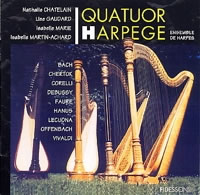Quatuor Harpege Volume 1
Buy this album now CD: £14.00 + p&p |
| Antonio Vivaldi (1678-1741) | Concerto grosso no 11, Opus 3 | ||
| (transcription C. Vellones) | 1 |
Allegro | 1.04 |
2 |
Adagio | 0.35 |
|
3 |
Allegro | 3.10 |
|
4 |
Largo | 2.43 |
|
5 |
Allegro | 3.02 |
|
| Arcangelo Corelli (1653-1713) | 6 |
Sarabande |
2.46 |
| (transcription G.L Tocchi) | 7 |
Gigue | 2.29 |
8 |
Badinerie | 1.30 |
|
| Jean-Chretien
Bach (1735-1782) |
Sonate
en sal mineur |
||
| (transcription C. Vellanes) | 9 |
Allegro | 2.30 |
10 |
Menuet | 3.16 |
|
| Jacques
Offenbach (1819-1880) |
Barcarolle |
||
| (arrangement Fr. J. Breuer) | 11 |
extrait des“Contes d'Hoffmann" | 2.32 |
| Gabriel
Faure (1845 - 1924) |
Berceuse | ||
| (transcription I. Marie) | 12 |
extrait de "Dolly" | 2.39 |
| Claude Debussy (1862-1918) | Petite Suite | ||
| (transcription I. Marie) | 13 |
En
bateau |
3.54 |
14 |
Cortege | 3.37 |
|
15 |
Menuet | 3.27 |
|
16 |
Ballet | 3.21 |
|
| Ernesto
Lecuona (1896-1963) |
17 |
Malagueña | 5.24 |
| (transcription A. Sparnon) | |||
| Jan Hanüs (1915) | “Ninfa e Pan" | ||
18 |
Introduction | 2.40 |
|
19 |
Toccata | 4.18 |
|
| Pearl
Chertok (1908-1980) |
20 |
Harpicide at Midnight | 2.39 |
| (arrangement C. Mathieu) | |||
Total
Time |
57.50 |
Four young harpists, having brilliantly finished their music studies, met at Geneva in 1990, with the desire to play together and assemble a repertoire. A
harp quartet? that’s not easy one has to find the scores
and then adapt them - which has been done so often before (often
by illustrious composers). Isabelle Marie, a first prize winner
of the Fans Academy started the work. Nathalie
Chatelain, Line Gaudard, Isabelle Martin-Achard Moliet are
holders of virtuoso awards of the Lausanne Academy, from the
class of Chantal Mathieu-Baiavoine. The harp quartet started
successfully in Geneva the aim of this formation is the research
of a style different to the traditional image of a lounge harpist
or the often discreet orchestra harpist. Claudine Vellones The harp quartet has performed many times in Geneva, in all the major towns of Switzerland. in France and Luxembourg. They were invited in March 1994 to Fans to perform at MUSICORA in a concert broadcasted live on several cultural channels. The harp quartet had already inspired several contemporary composers and wishes to further develop their repertoire as well as their instrumental and educational activities. Programme notes Antonio Vivaldi (1678-1741) Concerto Grosso Nr. 11 This venitian of radiant personality called ‘the red priest’ was a distinguished violinist and a composer full of genius. The concerto for two violins in D minor R.V. 565 Op. 5, starts with a lively allegro modulating to a dominant cadence. A fugue theme is then exposed and develops con brio up to the final free cadence. The argo is a meditative dreamy song, supported by a pastoral rythm. In the final allegro, Vivaldi introduces a surprising chromatism which reveals his eloquent imagination. The transcription for the quartet is by Claudine Vellones. Arcangelo Corelli (1653-1713) Saraband, Jig and Jest It was in Rome, where the marvellous violinist lived since 1681, that Corelli wrote and published several instrumental Sonata pieces. Protected by the Cardinal Ottoboni, nephew of the Pope. he lived fully his life of virtuoso and composer, surrounded by respect and admiration. Several Sonata pieces for two violins and bass contain dance movements and these famous compositions, transcribed by Gian-Luigi Toochi, form a pleasant little suite. Jean-Chretien Bach (1735-1782) Sonata in G major Jean-Chretien Bach was the eleventh son of Jean Sebastien. He studied music with his brother Carl- Philipe Emmanuel and then after in Italy where he was appointed as organist of the Milan Dome. He then settled permanently in London from 1762 and became a brilliant composer. The style of this sonata, curiously composed of two movements, is similar to that of Joseph Haydn being optimistic and joyful. This adaptation by Claudine Vellones is taken from the original version for two harpsichords. Jacques
Offenbach (1819-1880) Barcarolle. Extract
from “The Tales of Hoffmann” Gabriel
Faure (1845-1924) Lullaby Claude
Debussy (1862-1918) Little Suite Ernesto
Lecuona (1896-1963 ) Malaguena. Jan
Hanus (1915) Nymph and Pan. Pearl
Chertok (1808-1880) Harpicide at Midnight. |
Credits Enregistrement
effectue en mars 1994 au studio d’enregistrement FIDESSON |
| Title: | Quatuor Harpege Volume 1 |
| Artists: | Quatuor Harpege |
| Instruments: | Four Harps |
| Genre: | Classical |
| Format: | CD |
| Our Ref: | A0053 |
| MCPS: | CF1.013 |
| Label: | Fidesson |
| Year: | 1994 |
| Origin: | Switzerland |
 The
first album from Quatuor Harpege, harp
quartet, which was formed in Geneva in 1990, While the music
is, in the main, standard solo harp repertoire, hearing these
works as a quartet is rather unusual.
The
first album from Quatuor Harpege, harp
quartet, which was formed in Geneva in 1990, While the music
is, in the main, standard solo harp repertoire, hearing these
works as a quartet is rather unusual. 





